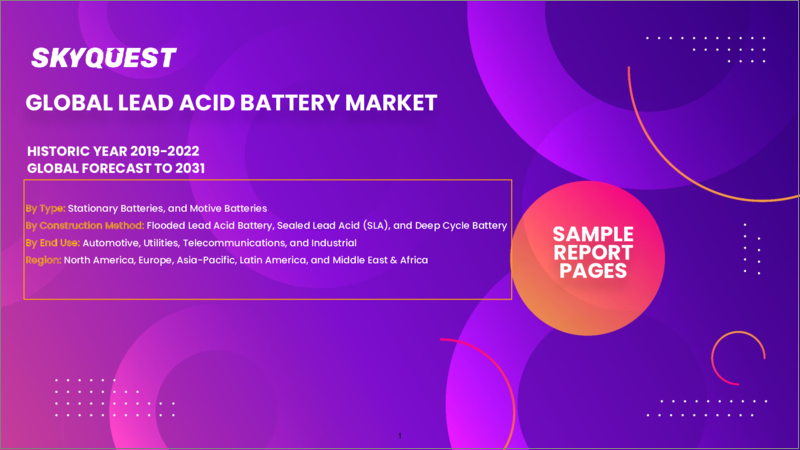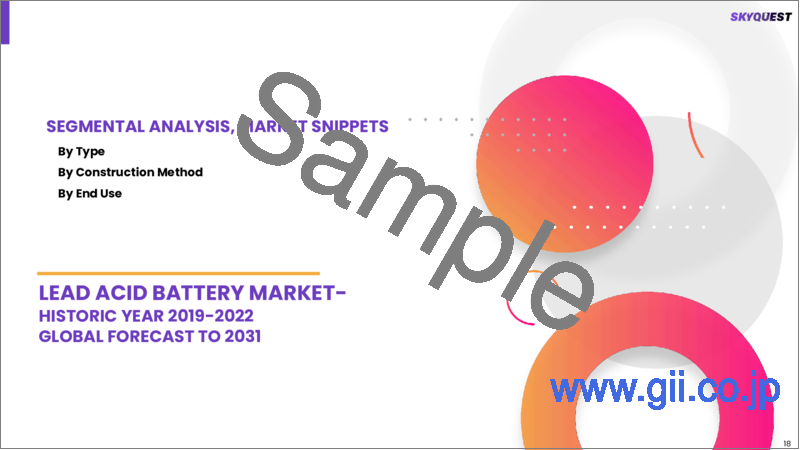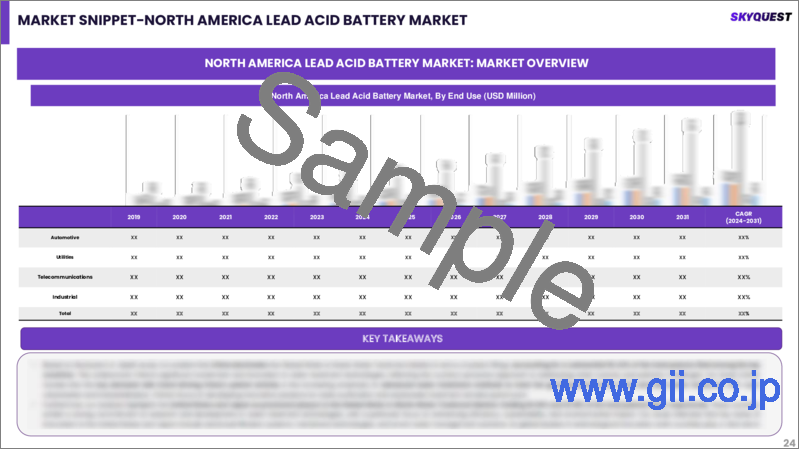|
|
市場調査レポート
商品コード
1539567
鉛蓄電池の市場規模、シェア、成長分析:製品別、技術別、施工法別、地域別 - 産業予測、2024年~2031年Lead Acid Battery Market Size, Share, Growth Analysis, By Product (Motive, Stationary), By Technology (Basic Lead Acid Battery, Advanced Lead Acid Battery), By Construction method (Flooded, VRLA Battery), By Region - Industry Forecast 2024-2031 |
||||||
|
|||||||
| 鉛蓄電池の市場規模、シェア、成長分析:製品別、技術別、施工法別、地域別 - 産業予測、2024年~2031年 |
|
出版日: 2024年08月14日
発行: SkyQuest
ページ情報: 英文 223 Pages
納期: 3~5営業日
|
- 全表示
- 概要
- 目次
世界の鉛蓄電池の市場規模は、2022年に403億2,000万米ドルとなり、予測期間(2024年~2031年)のCAGRは5%で、2023年の423億4,000万米ドルから、2031年までには625億6,000万米ドルに成長する見通しです。
世界の鉛蓄電池市場は、自動車や無停電電源装置(UPS)での鉛蓄電池使用の増加や製造技術の進歩により、大幅な成長が見込まれています。また、オフグリッド発電における鉛蓄電池の需要の高まりも、市場拡大を促進すると予想されます。さらに、運輸セクターの発展やエネルギー貯蔵アプリケーションの採用増加が、近い将来、鉛蓄電池の需要をさらに押し上げる可能性が高いです。銀行、石油・ガス、ヘルスケア、化学など、さまざまな分野でUPSシステムのニーズが高まっていることも、市場の成長に寄与しています。しかし、鉛バッテリーに関連する環境問題により、市場は課題に直面しています。さらに、技術の進歩によるリチウムイオン電池のコスト低下が、鉛電池の需要を鈍らせています。この動向は、特にエネルギー貯蔵市場においてリチウムイオン技術がよりコスト効率的になるにつれて続くと予想され、鉛蓄電池市場の成長を制限しています。プラス面としては、インド、ブラジル、メキシコ、韓国、インドネシア、タイ、ベトナムなどの国々における自動車産業の拡大が世界市場を支えるものと予想されます。環境に優しい輸送ソリューションへのニーズと継続的な技術革新に後押しされた電気自動車への需要の高まりは、今後数年間、鉛蓄電池の需要を促進すると予想されます。
目次
イントロダクション
- 調査の目的
- 定義
- 市場範囲
調査手法
- 情報調達
- 二次・一次情報源
- 市場規模予測
- 市場の前提条件と制限
エグゼクティブサマリー
- 市場概要見通し
- 供給需要動向分析
- セグメント別機会分析
市場力学と見通し
- 市場力学
- 促進要因
- 機会
- 抑制要因
- 課題
- ポーターの分析
主要な市場の考察
- 市場の主要な成功要因
- 競合の程度
- 主要な投資機会
- 市場魅力度指数
- エコシステムマッピング
- 特許分析
- 価格分析
- 貿易分析
- 消費者と購買基準
- 規制分析
- 技術分析
- ケーススタディ分析
鉛蓄電池市場:技術別
- 市場概要
- 基本鉛蓄電池
- 先進鉛蓄電池
- その他
鉛蓄電池市場:タイプ別
- 市場概要
- 据え置き型
- 動力用
鉛蓄電池市場:工法別
- 市場概要
- 洪水
- VRLAバッテリー
鉛蓄電池市場:エンドユーザー別
- 市場概要
- ユーティリティ
- 輸送
- 商業・住宅
鉛蓄電池市場規模:地域別
- 市場概要
- 北米
- 米国
- カナダ
- 欧州
- ドイツ
- 英国
- フランス
- イタリア
- スペイン
- その他欧州地域
- アジア太平洋
- 中国
- インド
- 日本
- 韓国
- その他アジア太平洋
- ラテンアメリカ
- ブラジル
- その他ラテンアメリカ地域
- 中東・アフリカ(MEA)
- GCC諸国
- 南アフリカ
- その他中東・アフリカ地域
競合情勢
- 上位5社の比較
- 主要企業の市場ポジショニング(2023年)
- 主要な市場企業が採用した戦略
- 市場における最近の活動
- 主要企業の市場シェア(2023年)
主要企業プロファイル
- Exide Technologies(US)
- East Penn Manufacturing(US)
- GS Yuasa Corporation(Japan)
- EnerSys(US)
- Clarios(US)
- Leoch International(China)
- Crown Battery Manufacturing(US)
- HOPPECKE Batterien(Germany)
- Amara Raja Batteries(India)
- EnerSys Europe(Belgium)
- Exide Industries(India)
- Narada Power Source(China)
- FIAMM Energy Technology(Italy)
- Power Sonic Corporation(US)
- Chaowei Power Holdings(China)
- Daramic(US)
- Panasonic Corporation(Japan)
- Envirosystems LLC(US)
- HBL Power Systems Ltd.(India)
- Banner Batterien(Austria)
- Microtex Energy Private Limited(India)
Global Lead Acid Battery Market size was valued at USD 40.32 Billion in 2022 and is poised to grow from USD 42.34 Billion in 2023 to USD 62.56 Billion by 2031, at a CAGR of 5% during the forecast period (2024-2031).
The global lead-acid battery market is poised for substantial growth, driven by the increasing use of these batteries in automobiles and uninterruptible power supplies (UPS), as well as advancements in manufacturing techniques. The growing demand for lead-acid batteries in off-grid power generation is also expected to propel market expansion. Moreover, developments in the transportation sector and the rising adoption of energy storage applications are likely to further boost the demand for lead-acid batteries in the near future. The growing need for UPS systems across various sectors, including banking, oil and gas, healthcare, and chemicals, has also contributed to the market's growth. However, the market faces challenges due to environmental concerns associated with lead batteries. Additionally, the declining costs of lithium-ion batteries, driven by technological advancements, have slowed the demand for lead-acid batteries. This trend is expected to continue as lithium-ion technology becomes more cost-effective, particularly in energy storage markets, thereby limiting the growth of the lead-acid battery market. On the positive side, the expansion of the automotive industry in countries such as India, Brazil, Mexico, South Korea, Indonesia, Thailand, and Vietnam is expected to support the global market. The rising demand for electric vehicles, fueled by the need for environmentally friendly transportation solutions and ongoing technological innovations, is anticipated to drive the demand for lead-acid batteries in the coming years.
Top-down and bottom-up approaches were used to estimate and validate the size of the global Lead Acid Battery market and to estimate the size of various other dependent submarkets. The research methodology used to estimate the market size includes the following details: The key players in the market were identified through secondary research, and their market shares in the respective regions were determined through primary and secondary research. This entire procedure includes the study of the annual and financial reports of the top market players and extensive interviews for key insights from industry leaders such as CEOs, VPs, directors, and marketing executives. All percentage shares split, and breakdowns were determined using secondary sources and verified through Primary sources. All possible parameters that affect the markets covered in this research study have been accounted for, viewed in extensive detail, verified through primary research, and analyzed to get the final quantitative and qualitative data.
Global Lead Acid Battery Market Segmental Analysis
The global lead acid battery market is segmented based on type, construction, technology, end user, and region. In terms of type, the market is segmented into Stationary, and Motive. Based on construction method, the market is segmented flooded and VRLA Battery. Based on technology, the market is segmented into advanced lead acid batteries, and basic lead acid batteries. Based on end user, the market is segmented into Utility, Transportation, Industrial, and Commercial & Residential. By region, the market is segmented into North America, Europe, Asia Pacific, Middle East and Africa, and Latin America.
Drivers of the Global Lead Acid Battery Market
The automotive industry plays a crucial role in driving the lead acid battery market. These batteries are extensively used in vehicles such as cars, trucks, and motorcycles for starting, lighting, and ignition (SLI) applications, making them a key component in automotive operations. The global rise in automobile production and sales has significantly boosted the demand for lead acid batteries in this sector. As more vehicles are manufactured and sold worldwide, the need for reliable lead acid batteries continues to grow, further propelling the market's expansion.
Restraints in the Global Lead Acid Battery Market
Improper handling of lead-acid batteries can lead to significant risks, including serious injuries, due to their ability to deliver a high charge rapidly. During charging, these batteries release oxygen and hydrogen, which can create a potential explosion hazard. Oxygen supports combustion, while hydrogen is highly flammable and can easily ignite.To ensure safety, it is advised that flooded lead-acid batteries should not be used indoors and should be stored in a battery box or enclosure with adequate ventilation. Following these safety guidelines helps reduce the potential dangers associated with lead-acid batteries.
Market Trends of the Global Lead Acid Battery Market
The use of lead-acid batteries in energy storage applications is on the rise, especially within renewable energy systems and off-grid power solutions. Their growing adoption in these areas reflects the need for dependable storage solutions that can effectively support energy demands. The increasing demand for reliable and cost-effective energy storage options is a key factor fueling the growth of lead-acid batteries in these applications. As the energy landscape evolves, lead-acid batteries continue to play a crucial role in meeting storage requirements.
Table of Contents
Introduction
- Objectives of the Study
- Definitions
- Market Scope
Research Methodology
- Information Procurement
- Secondary & Primary Data Sources
- Market Size Estimation
- Market Assumptions & Limitations
Executive Summary
- Market Overview Outlook
- Supply Demand Trend Analysis
- Segmental Opportunity Analysis
Market Dynamics & Outlook
- Market Dynamics
- Drivers
- Opportunities
- Restraints
- Challenges
- Porters Analysis
- Competitive rivalry
- Threat of Substitute Products
- Bargaining Power of Buyers
- Threat of New Entrants
- Bargaining Power of Suppliers
Key Market Insights
- Key Success Factors of The Market
- Degree Of Competition
- Top Investment Pockets
- Market Attractive Index
- Ecosystem Mapping
- Patent Analysis
- Pricing Analysis
- Trade Analysis
- Consumer And Buying Criteria
- Regulatory Analysis
- Technology Analysis
- Case Study Analysis
Global Lead Acid Battery Market by Technology
- Market Overview
- Basic Lead Acid Battery
- Advanced Lead Acid Battery
- others
Global Lead Acid Battery Market by type
- Market Overview
- Stationery
- Motive
Global Lead Acid Battery Market by Construction Method
- Market Overview
- Flooded
- Vrla Battery
Global Lead Acid Battery Market by End-user
- Market Overview
- Utility
- Transportation
- Industrial
- Commercial & Residential
Global Lead Acid Battery Market Size by Region
- Market Overview
- North America
- USA
- Canada
- Europe
- Germany
- UK
- France
- Italy
- Spain
- Rest of Europe
- Asia Pacific
- China
- India
- Japan
- South Korea
- Rest of Asia-Pacific
- Latin America
- Brazil
- Rest of Latin America
- Middle East & Africa (MEA)
- GCC Countries
- South Africa
- Rest of MEA
Competitive Landscape
- Top 5 Player Comparison
- Market Positioning of Key Players, 2023
- Strategies Adopted by Key Market Players
- Recent Activities in the Market
- Key Companies Market Share (%), 2023
Key Company Profiles
- Exide Technologies (US)
- Company Overview
- Business Segment Overview
- Financial Updates
- Key Developments
- East Penn Manufacturing (US)
- Company Overview
- Business Segment Overview
- Financial Updates
- Key Developments
- GS Yuasa Corporation (Japan)
- Company Overview
- Business Segment Overview
- Financial Updates
- Key Developments
- EnerSys (US)
- Company Overview
- Business Segment Overview
- Financial Updates
- Key Developments
- Clarios (US)
- Company Overview
- Business Segment Overview
- Financial Updates
- Key Developments
- Leoch International (China)
- Company Overview
- Business Segment Overview
- Financial Updates
- Key Developments
- Crown Battery Manufacturing (US)
- Company Overview
- Business Segment Overview
- Financial Updates
- Key Developments
- HOPPECKE Batterien (Germany)
- Company Overview
- Business Segment Overview
- Financial Updates
- Key Developments
- Amara Raja Batteries (India)
- Company Overview
- Business Segment Overview
- Financial Updates
- Key Developments
- EnerSys Europe (Belgium)
- Company Overview
- Business Segment Overview
- Financial Updates
- Key Developments
- Exide Industries (India)
- Company Overview
- Business Segment Overview
- Financial Updates
- Key Developments
- Narada Power Source (China)
- Company Overview
- Business Segment Overview
- Financial Updates
- Key Developments
- FIAMM Energy Technology (Italy)
- Company Overview
- Business Segment Overview
- Financial Updates
- Key Developments
- Power Sonic Corporation (US)
- Company Overview
- Business Segment Overview
- Financial Updates
- Key Developments
- Chaowei Power Holdings (China)
- Company Overview
- Business Segment Overview
- Financial Updates
- Key Developments
- Daramic (US)
- Company Overview
- Business Segment Overview
- Financial Updates
- Key Developments
- Panasonic Corporation (Japan)
- Company Overview
- Business Segment Overview
- Financial Updates
- Key Developments
- Envirosystems LLC (US)
- Company Overview
- Business Segment Overview
- Financial Updates
- Key Developments
- HBL Power Systems Ltd. (India)
- Company Overview
- Business Segment Overview
- Financial Updates
- Key Developments
- Banner Batterien (Austria)
- Company Overview
- Business Segment Overview
- Financial Updates
- Key Developments
- Microtex Energy Private Limited (India)
- Company Overview
- Business Segment Overview
- Financial Updates
- Key Developments





